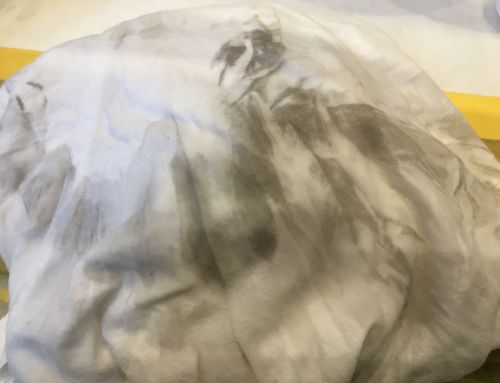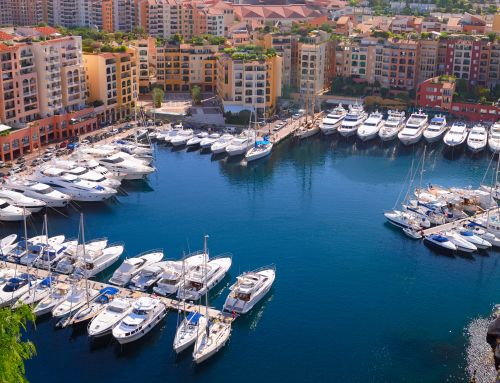Two decades ago life was relatively simple for yacht painters. We all worked in a very different industry back then, when a deadline was a moveable feast and yards understood the need for proper painting. Then came the boom … and the pressure on painters grew in earnest. Joop Ellenbroek, managing director of CCS Yacht Coating Services in the Netherlands, takes a broad brush stroke through the past, present and future of the yacht painting sector.
As the superyacht industry started to grow in the ’90s there was much less time available to complete projects. Pressure intensified to shift the current build out of the hall so that the next one could get under way. As one of the last pieces of the construction jigsaw, painting and paint quality inevitably began to suffer. This applied not only to the yachting world. I have seen major offshore platforms being launched with 10 painters still on board finishing the paint. In a business-oriented world money talks and time is money …
Reflecting demand
With superyacht yards receiving an increasing number of orders there was also a growing demand for skilled labour. Paint contractors could not respond in kind and the combination of time restrictions and unskilled labour led to a number of warranty issues. These often involved cosmetic problems, which is not surprising. Even with all the time in the world to complete the task an element of controversy is inevitable when people require a mirror-like finish to be produced in a construction environment.
I cannot stress enough that paint is only a semi-finished product, one that has to be applied under difficult conditions. The paint in a tin is worthless to owners if it is not properly applied by people who have the time they need and the requisite skills required: this goes beyond initial good looks. Once out on the ocean that paint has to cope with the most taxing environment imaginable.
The jury’s out
Back to the ’90s … As the decade came to a close there was an increasing awareness that something had to be done. I was often asked by the parties involved in a new build to act as a judge in disputes between yards and owners over a yacht’s coating. It was obvious that some commercial shipbuilders with little or no knowledge of the specifics of yacht building saw an opportunity to join
the burgeoning yacht world. I don’t question their motives, but this situation certainly ended up with some major paint disasters.
By the early 2000s I felt compelled to seek change. Paint-work is the biggest sub-contractor role on a yacht and I was often being asked as a surveyor to make subjective decisions that would cost several hundred thousand dollars if they resulted in a repaint. It was amazing to consider that there were standards for the smallest products and yet no fixed standard existed, regulatory or otherwise, for how a multi-million-dollar yacht should look.
It was obvious that some commercial shipbuilders with little or no knowledge of the specifics of yacht building saw an opportunity to join the burgeoning yacht world. I don’t question their motives, but this situation certainly ended up in some major paint disasters.
So, in 2001 we made the first attempt to come to a more practical and uniform description of the quality of yacht fairing and coatings, one that excluded at least some of the subjective assessments. The objective of the paint standards concept was to create a measurable standard based on the actual situation and experience amongst other factors. This was the start of a development related to International Organization for Standardization (ISO) and the International Council of Marine Industry Associations (ICOMIA) standards that continues to this day, where cosmetic quality is laid down in figures and tangible qualities such as gloss, dust and orange peel are included in contracts and specifications. As the demand for qualitative, quantifiable standards grew, so too did the number of surveyors and inspectors employed to check on the process and the resulting quality.
Rules and regulations
In the mid-2000s another major influence became a factor as paint companies felt the pressure of new regulations relating to solvents, emissions and hazardous materials. They were forced to change the formulation of their product. This only served to remind us that some of those components had been put in the tin for a good reason. It was not always easy to replace such materials and paints started looking less aesthetically attractive.
This, in turn, led to a whole new era of complaints from owners and yards, which only got worse in 2008 when – for good reasons – the leading paint manufacturer reformulated its topcoat. This new formulation displayed undesirable surface effects on several projects, presumably caused by a higher sensitivity to minor contaminations on the surface and a different surface texture. It also reconfirmed the need for better management and control of the cleaning, preparation and application process.
Paint companies have responded to these developments in general by stressing the need to ‘manage expectations’. What they are really saying in fact is that people need to accept lower quality. I understand the challenges faced when legislation is enforced and therefore changes the raw materials with which companies work, but I would still argue that time, effort and skills are the real issues and, given that, the same quality can be achieved with the new paint compositions. The best sub-contractors are currently working very hard on issues such as conditioning the painting environment, bringing in humidity controls, adjusting spray techniques and so on.
Paint companies have responded to these developments in general by stressing the need to ‘manage expectations’. What they are really saying in fact is that people need to accept lower quality.
The yards have an instrumental role in getting this right and their willingness to play ball will be crucial. I am aware of current situations where yacht builders are making business decisions to cut the time earmarked for production in order to speed up delivery, resulting in serious consequences for paint quality. The crisis has led to falling prices and now the pressure on the painters is coming from a different angle. It still means insufficient time and money!
Professionalisation
A more positive development I see is the professionalisation of the industry as yards become more organised and implement some impressive management systems. Some yards have already recognised the high cost of paint issues in terms of money and a loss of reputation. They are investing in infrastructure and improved conditions, combining that with proper management of paint matters at the right level in the organisation. We need more of this professional approach to paint by yards and contractors, with the goal to achieve high quality in one go and avoid rejections and paint issues.
The need for professionalism also applies to us as surveyors. It is important to continue to weed out subjectivity as much as possible, although it can never be completely ignored, as you cannot quantify everything. The professionalisation of surveyors is in full swing as the International Institute of Marine Surveying (IIMS) is starting a course specifically dedicated to train yacht coating inspectors and surveyors. I am involved in this working group and the first courses are planned for this year.
I would like to add that my view of the role of surveyors has radically changed over the years. The days have gone when we used to make an inspection, file a report, then go home and wait to discover the following week whether the parties involved had listened. Modern surveyors need to be involved in the whole process and act as an inspector/consultant with the objective to get things right in the first place. We are not shying away from situations when we are asked to recommend how to spray and how to be more cost effective. Perceptions are clearly changing and people are seeing that qualified surveyors can provide serious added value.
Green matters
The major challenge that we have for the future remains green legislation. Environmental sustainability and quality control is fast becoming mission-critical, and shipyards, yacht paint production companies and paint applicators are recognising the importance and effects that regulatory changes potentially have on their business and their product.
This is the background to the new strategic alliance with ICOMIA to deliver environmental and quality control consultancy services for the superyacht industry. Our goal is to jointly provide consultancy services to the yards, paint contractors and other organisations in the superyacht and recreational marine industries as they strive to meet the imminent new EU and global environmental legislation related to coatings, air and water.
ICOMIA will monitor these evolving regulations and provide specialist advice related to the EU and global bodies such as ISO and IMO. This will help us ensure that industry players of all sizes can benefit practically from knowledge of the most up-to-date legislation, regulations and standards. I believe that this alliance can be a turning point for the superyacht industry, which has been demanding better quality control and assessment of yacht coatings as well as sustainable coating practices.
Thinking ahead
Another important development is that some superyacht designs are becoming so exotic that it is increasingly difficult to apply the traditional fairing and coating. The effect of radical designs in terms of interfering with good painting practice should be checked at the earliest design stage. A lot of designers have very limited understanding of the troubles and the potential problems they are storing up for those who must apply coating materials for protection and cosmetic appearance on their beautiful creations!
In a similar vein, we have also seen the introduction of exotic topcoats/final coatings over the past couple of years. Superyachts are being spec’d with metallic paints and pearlescent coatings. While these might look fabulouson a flat surface or very smooth curve, surfaces with even the slightest dents in them are a serious challenge. In a nutshell, the dent is magnified by the fact that the dents change colour and the perception of colour is different. It is one thing to apply a metallic top coat to a fender of a car, but the application of a metallic coating on a large yacht is of a very different order.
It is one thing to apply a metallic top coat to a fender of a car, but the application of a metallic coating on a large yacht is of a very different order.
Human factor
Let me conclude by reminding everyone that the vast majority of all problems with paint are caused either by the application process, poor maintenance or construction/ outfitting issues, not the quality of the product itself. It would be overly optimistic to suggest that problems with paint can be avoided altogether as paint is a semi-finished material that needs to be applied by human beings under difficult conditions.
The vast majority of all problems with paint are caused either by the application process, poor maintenance or construction/ outfitting issues, not the quality of the product itself.
When yards recognise the need to be proactive in addressing paint issues and see the entire paint procedure from a professional point of view, great things can be achieved. The ultimate goal – to deliver yachts in time without paint problems and paint warranty costs – will be met. Yards that fail to actively manage their paint sub-contractor and/or invest in their organisation and infrastructure will continue to run the risk that every new build delivery is accompanied by disputes over paint.
Is it worth it?
Written by Joop Ellenbroek



